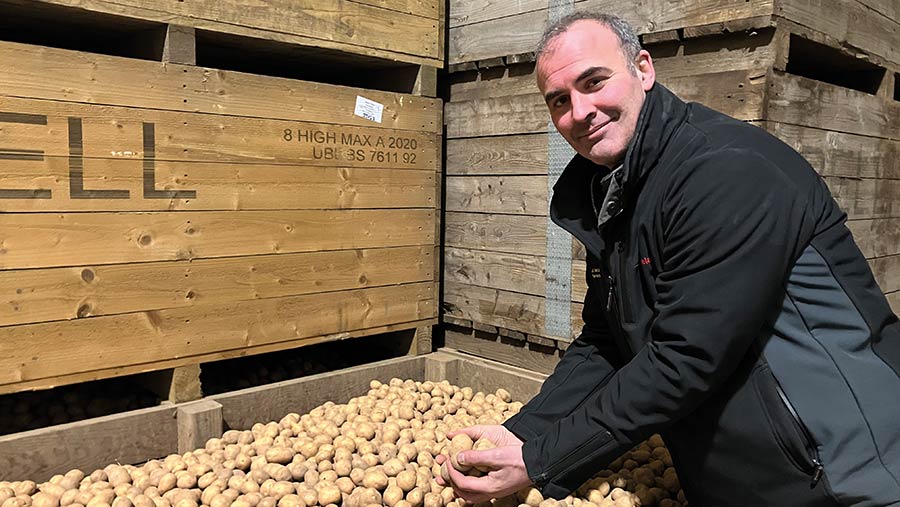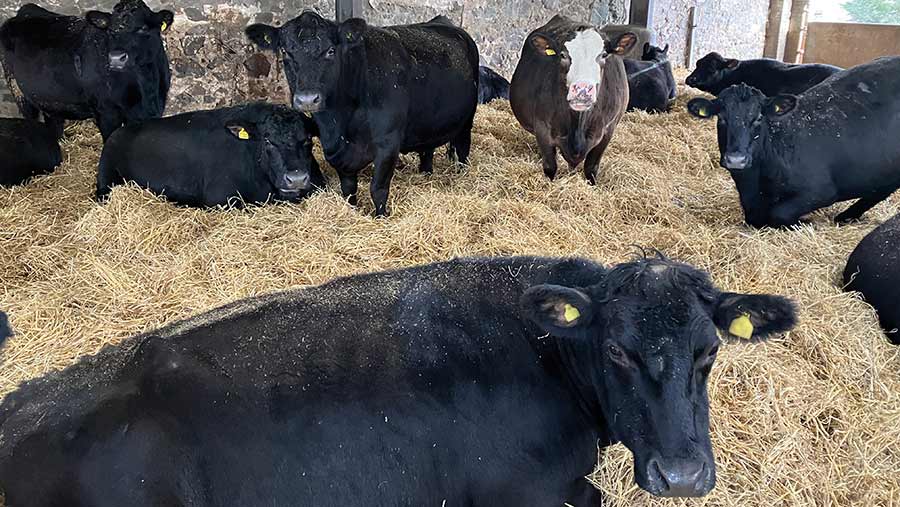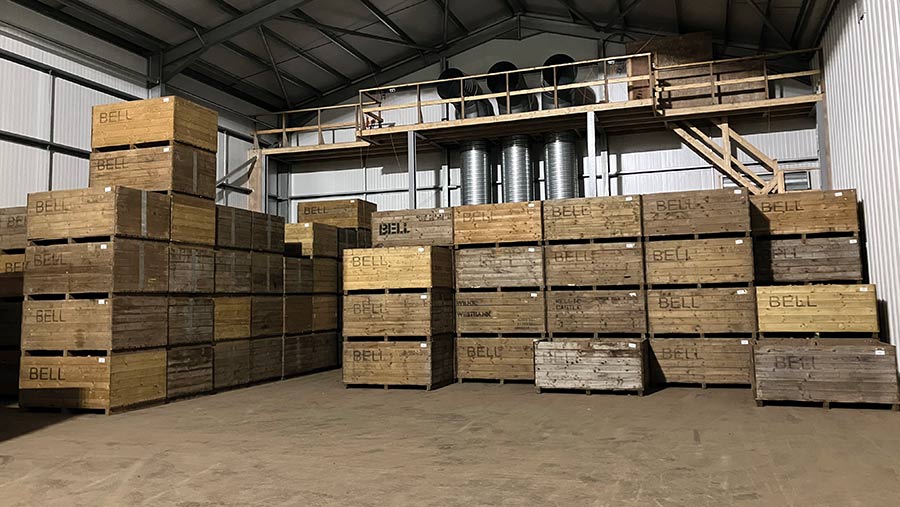Variety choice and targeted N are vital for Scottish grower’s potato profit
 © MAG/Emma Gillbard
© MAG/Emma Gillbard Potatoes are the main cash crop for Scottish mixed farmer David Bell who farms in Fife, where a focus on variety choice and targeted nutrition are key factors that lead to a profitable enterprise.
At a time when the potato industry is struggling, with many growers cutting back production or getting out altogether, the difference between profit and loss rides heavily on efficient use of inputs and cost cutbacks.
See also: Advice for winter bean crops hit with chocolate spot disease
“Potatoes are a high-input, high-value crop. You can’t force them to be grown on soils which don’t allow as there is little room for error.
“With good inputs which include soil type, variety and nutrition you can achieve good outputs,” says Mr Bell.
Potatoes at a crossroads
It was eight years ago when potato production came to a crossroads at Upper Magus Farm.
Crops were not making sufficient returns, which left Mr Bell with two choices – either stop production altogether, or improve production efficiency.
The decision was made to continue, but place greater attention on variety, soils, nutrition and cultivation.
A new energy saving storage unit was also built on farm to secure the crop’s future.
Previously, cattle were the priority on the 400ha farm, but with potatoes becoming the main enterprise, Mr Bell needed a system which complemented cereal production and the 70 cow Aberdeen Angus suckler herd.
Together with the diverse integration of cattle, grass, cover crops, cereals and vining peas, soil organic matter levels have increased to an impressive 7-8%.
This busts the myths that potatoes cannot be grown as part of a sustainable rotation and contribute to healthy soil structure.
Variety choice
Mr Bell assessed field performance and historic yield data, prompting land which was either “too shallow, too deep or too wet” to be dropped from potato production which would otherwise limit margin.
A mix of early and main crop potatoes are now grown across a stable 42ha in a six- or seven-year rotation, helping to spread workload and keep workers and machines busy throughout the season.
Early planted salad potatoes Maris Peer and Gemson were selected to capture early market prices, with yields of 30t/ha.
“We had a previous bottleneck at harvest as crops seemed to ripen at once. Growing for the salad market means we can harvest salads before winter barley and increase our barley acreage.”
Gemson offers good resistance to powdery scab, blackleg, and potato leafroll virus and is comparable with mainstay variety Maris Peer.
In fact, it can outperform Maris Peer with its number of uniform tubers to hit market specs.
Main crop varieties include Saxon, Cultra and Maris Piper, which typically yield double at 60t/ha. These are harvested after the main cereal crops to further spread workload.
Mr Bell has even stopped feeding stock-grade potatoes to reduce the risk of scab disease being spread in manures.
“This may be overcautious, but could damage profits overtime,” he says.
Targeting variety, nutrition and irrigation
Matching variety selection to achieve targeted outcomes is key to profitable production, says Mr Bell.
This is why he is keen on accurately applying nutrition to improve efficiencies.
“When applying N we target crops on a field-by-field basis according to variety, soil type, yield history and previous cropping, using SAC technical notes.”
Nitrogen rates were scaled back to a 150kg N/ha average, with higher yields and better skin finish to show for it.
For example, Maris Piper witnessed a (10-15%) cut in N, but saw a 10-15% yield increase.
“Granted this is not all down to more precise N applications, but it is a major factor in improved marketable yield,” he adds.
A broad range of nutrition products are used to avoid over-reliance on one method of nutrition uptake, where farmyard manure is applied ahead of planting as a baseline soil amendment.
“Using a range of placement fertilisers, broadcast granular fertiliser and foliar feeds keep crops greener for longer in different environments when certain types of uptake may be limited,” he says.
Maris Piper tends to be the only variety which receives irrigation due to limited water access and Piper’s skin finish requirements.
Mr Bell also uses a Rhiza moisture probe both before and during the irrigation season to assess soil moisture levels.
Connected to a phone app, real-time data helps decipher whether irrigation is needed, optimising crop water intake and reducing unnecessary expenditure.

© MAG/Emma Gillbard
Cultivations and cover crops
Fuel makes up a significant proportion of potato input costs, where six passes are usually made through the soil to establish the crop.
“These are: plough, top down, openers, bed-tiller, soil separator and finally the planter.
“Although top down and bed-till passes are only used where necessary,” says Mr Bell.
It wasn’t until he discovered AHDB trial work through the Spot Farm network that he appreciated the benefits of cover crops and their effect on soils and began incorporating covers into the rotation.
“The covers aimed to take moisture out of the ground and break up the soil for easier cultivations, saving fuel and time,” he explains.
Selecting the right cover crop species is vital and can otherwise have negative consequences.
A recent potato cyst nematode (PCN) test revealed low populations across the farm, except for a small 3ha area.
Mr Bell assumes a cover crop of phacelia harboured the pest and is partly to blame.
He plans to plant the PCN-resistant variety Lenorma in the infected area to limit further build-up.
“Cover crops can make a fool out of you if not done right and must be strategically grown. We’ve tried broadcasting and cultivating them in the past, but failed.
“However, we’ve had particular success with a grass and clover mix which proved effective at diverting wild geese from attacking cereal crops – proving they can offer multiple benefits.”
New storage development and potato future

© MAG/Emma Gillbard
A significant investment in a new 1,000t potato storage facility (pictured) helped secure the future of potatoes at Upper Magus Farm.
The development, designed with energy efficiency and health and safety in mind, eliminated rent storage and transport costs.
“The new storage facility has been a real asset to the farm,” explains David Bell who visited a number of other farms before designing the store.
“I can’t recommend enough the importance of getting off-farm and engaging with other farmers to learn new things and gain new ideas – it has no doubt made me a better farmer,” he says.
Looking forward, he hopes industry promotes the consumer benefits of eating home-grown nutritious and environmentally friendly British potatoes.
“The green credentials of UK potatoes far outweigh pasta, rice and the devil food of sweet potatoes.
“If we are serious about reducing our carbon footprint then why are we not promoting UK potato produce? After all, they are a super food,” he says.

